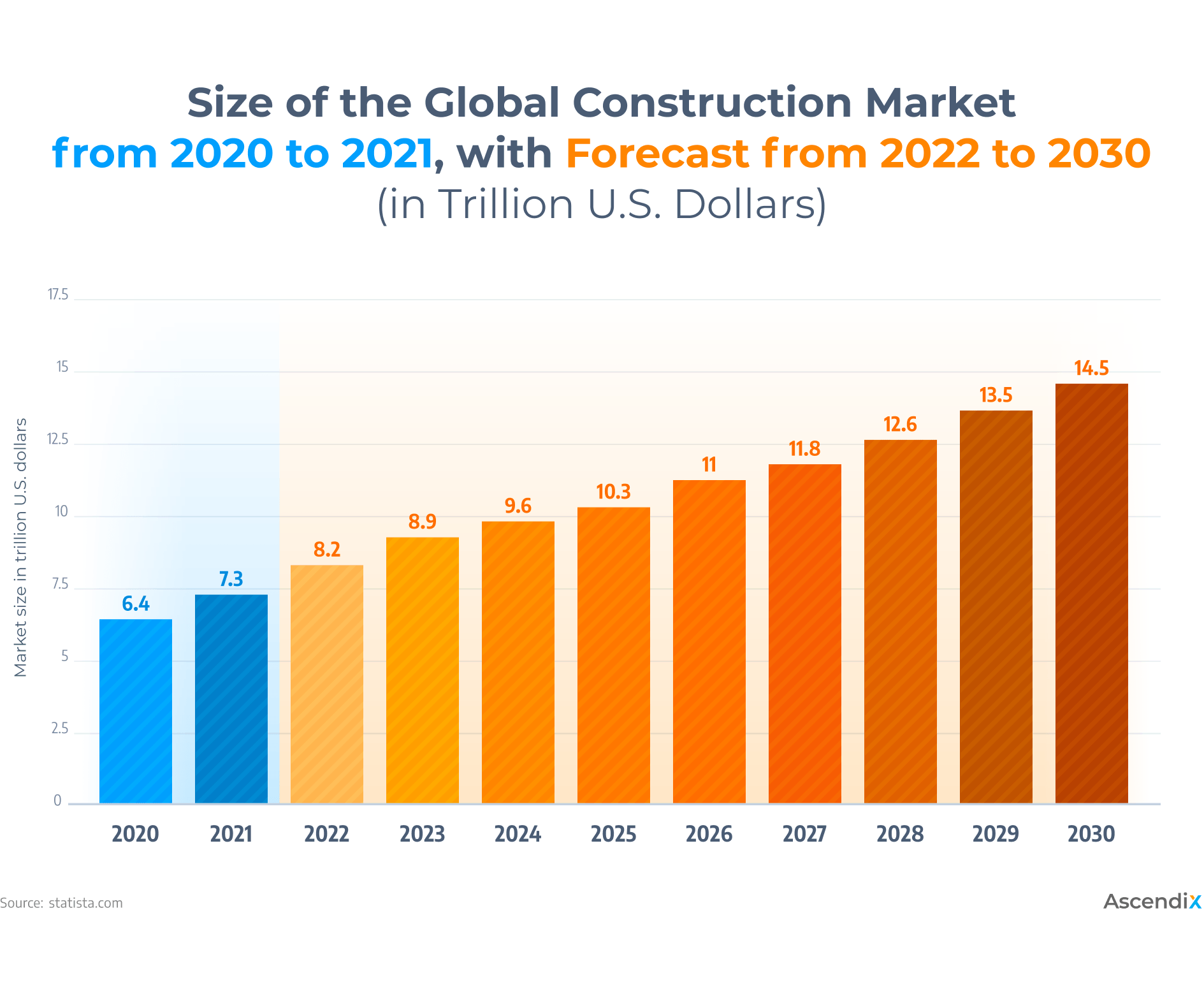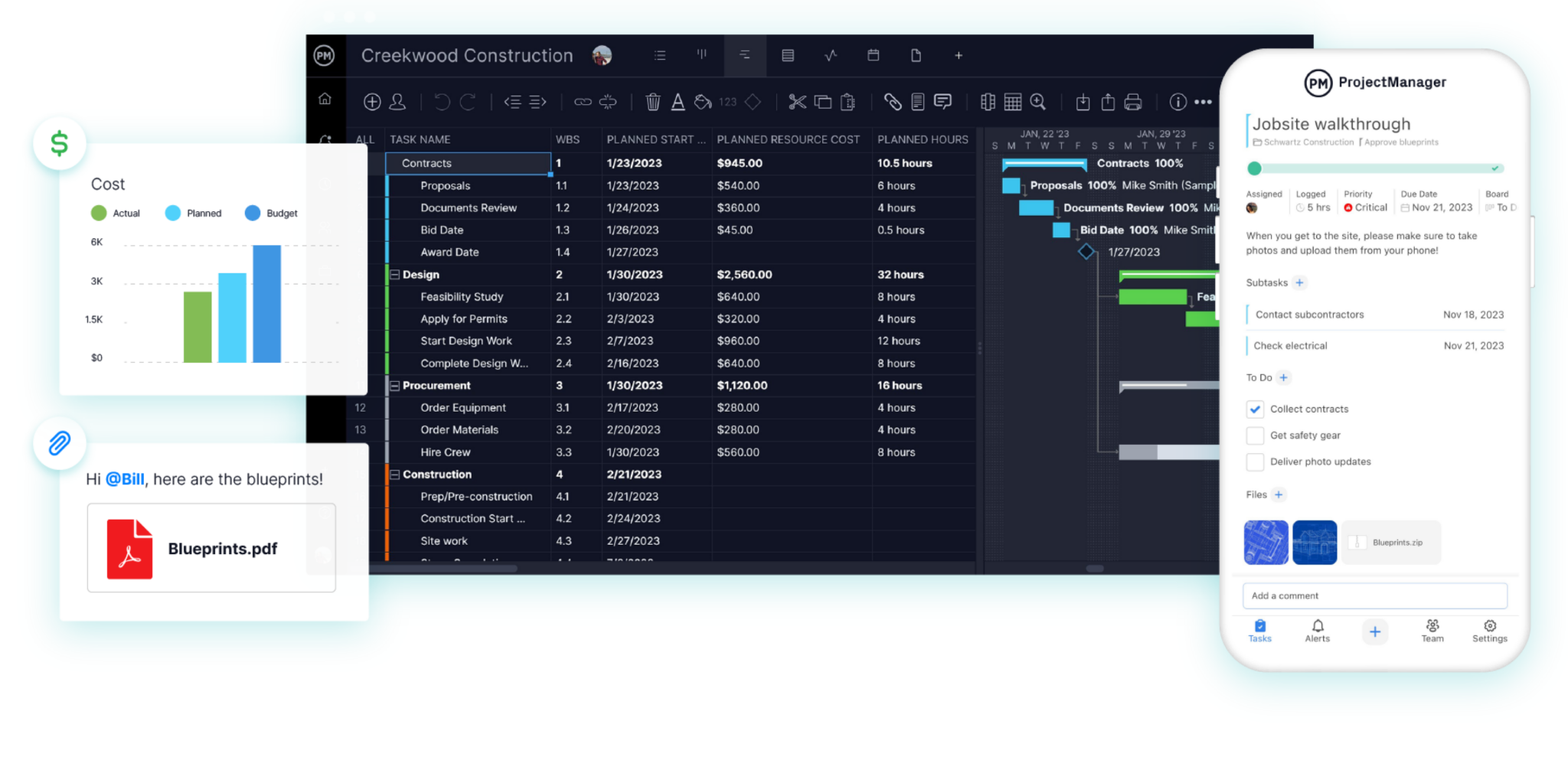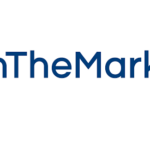Construction Apps are the new bricks and mortar
This month the leader in the field Ascendix, focuses on why having a construction App promises to solve delays, miscommunication, and cost overruns. A construction application makes it easier to coordinate teams, share information, and avoid costly mistakes. The result — projects stay on track from start to finish, as 18% of a build cost is actually the errors in the implementation from design to build, which traditionally has been until now a paper heavy ticket system.
Here Ascendix CEO & Co-founder Wes Snow‘s team unravels how these apps are developed, and why they are changing the construction industry.
Building a construction app improves project management, helps teams on job sites and in the office communicate more effectively, and makes cost estimation more precise.
With the global construction management software market projected to reach $2.71 billion by 2027 (source). This growth shows that more companies are turning to construction apps to work faster, improve safety, and manage tasks better.
 Construction market size
Construction market size
In construction, inefficiencies like material waste and miscommunication account for 35% of costs. Let’s see how construction apps are helping businesses:
| Role | Benefits |
|---|---|
| Project Managers | Gain full visibility into schedules, budgets, and resources, reducing project delays. |
| Field Workers | Access tools like blueprints, checklists, and progress updates on mobile devices in real time. |
| Construction Companies | Save money by cutting waste, improving communication, and avoiding rework caused by errors. |
| Safety Officers | Perform quicker site inspections, log incidents digitally, and track safety compliance seamlessly. |
| Clients/Stakeholders | Stay informed about project milestones, budgets, and timelines for better transparency. |
“Construction projects are becoming increasingly complex, and sticking to outdated methods can lead to costly setbacks. Firms that invest in construction apps can modernize their operations, reduce costs, and improve safety. ”
While ready-made solutions offer excellent features for general construction management, building a custom app is often the better choice in specific situations. Let’s explore these in detail:
1. Launching a Product for Other Businesses
If your company wants to create software to sell to other construction businesses, a custom app helps your product stand out. You can add features that solve specific problems, like managing subcontractors, creating detailed reports, or following unique rules and regulations. A custom app also lets you use your branding and build something that can grow with your customers’ needs.
2. Addressing Niche Requirements
Construction projects are not all the same. For example, homebuilding might need tools to manage homeowner approvals, while industrial projects might focus on scheduling heavy equipment or following strict safety rules. Ready-made apps are designed for general use and may not cover these specific needs. A custom app allows you to create tools and features that fit exactly how your team works.
3. Supporting Complex Integrations
Many construction companies already use tools like ERP systems (for managing business processes), BIM (for 3D building plans), or IoT devices (to monitor equipment). Ready-made apps often don’t work well with these tools, causing extra work or mistakes. A custom construction app can connect to all your systems, so they work together smoothly, saving time and improving accuracy.
How to Construct an App: Guide
Determined to build an app? Building a construction app requires a strategic approach. Our team prepared a guide with the essential steps involved in construction app development:
Step 1. Define Your Goals
The first step in developing a construction app is to clearly define what you want the app to achieve. Are you focusing on improving communication, optimizing scheduling, or tracking progress? Setting clear objectives ensures that the app serves a defined purpose.
💡 Advice: Having a clear goal from the start is crucial for developers to focus on features that matter most to users. If you need experts to validate your idea, the Ascendix team is here to help. Tell us about your project, and we’ll guide you through the process.
Step 2. Conduct Market Research
Market research is essential to understand what features are already offered by other construction apps and identify any gaps. Our take: look at competitor apps to see what works and what doesn’t. This research helps you build a unique app with features that fill the gaps in the market.
💡 Advice: Practice shows that analyzing existing apps helps developers avoid reinventing the wheel and instead focus on innovative solutions that address unfulfilled needs in the industry.
Step 3. Choose the Right Technology Stack
Now that we’ve covered the basics, let’s dive into the technical side of things. Choose the right technologies with the help of construction app developers to ensure your app performs well, scales effectively, and supports future updates.
💡 Advice: For instance, a construction app designed for on-site workers might need offline functionality to ensure accessibility in areas with poor connectivity. Meanwhile, apps focused on project management may require robust integrations with scheduling tools and document-sharing platforms. The decision should factor in your app’s primary use case, user expectations, and plans for scalability. If you’re curious about the technical details, discover more about our expertise here.
Step 4. Develop Core Features
A successful construction app begins by focusing on the key features that users need most. By prioritizing these, you can quickly solve key problems and offer real value right from the start.
| Core Feature | How It Helps Users |
|---|---|
| Raw Material Management | Allows users to send raw material requests, preventing delays and ensuring timely procurement. |
| Resource Management | Helps manage labor, workers, and employees efficiently, improving productivity and on-time project completion. |
| Attendance Management | Tracks employee working hours, allowing the admin to generate timesheets easily for payroll and record-keeping. |
| Payment Integration | Simplifies vendor payments, wages, and salaries through digital payments, reducing HR workload and errors. |
| Vendor Management | Connects to vendors for seamless material orders, real-time stock updates, and confirmation of orders. |
| Update Task Status | Ensures workers update their task progress, providing better accountability and clarity on project milestones. |
| Document Sharing | Enables secure sharing of blueprints, contracts, and project documents, making it easier to collaborate and reduce errors. |
| Time Tracking | Helps monitor work hours for individual workers, ensuring productivity and helping with payroll and project timelines. |
| Project Budgeting | Keeps track of project expenses and budget allocations, helping to stay within financial limits and avoid overspending. |
| Chat Messaging | Facilitates instant communication between field workers, project managers, and clients, improving coordination and decision-making. |
| Safety Management | Provides a way to track safety inspections, log incidents, and ensure compliance with safety regulations to reduce risks. |

Construction management app | Source: ProjectManager
💡 Advice: Starting with core features is crucial as they shape the app’s initial impact on users. For example, using predictive analytics in resource management can help forecast labor needs, ensuring the right number of workers are scheduled at the right time. This improves efficiency and reduces delays. Once the app gains traction, additional features can be added to enhance the experience.
Step 5. UX & UI Design
Now, it’s time for the visual component. Designing a user-friendly interface is key to ensuring that your app is easy to navigate. This is beneficial especially for construction workers in the field.
💡 We believe: A well-designed interface makes the difference. Our developers and designers know that simplicity and clarity are the top priorities for construction apps, where quick access to essential information is vital. For more on creating a compelling design, explore our UI/UX design services.
Step 6. Launch MVP and Maintain Updates
Once the app is developed and tested, start by launching it on a small scale. We recommend launching the app in phases to collect valuable feedback from real users. This strategy allows developers to pinpoint areas for improvement and refine the app, ensuring it becomes more user-friendly and functional based on practical insights.
After the initial release, regular maintenance and updates are essential. These updates help fix bugs, introduce new features, and maintain app security.
💡 We suggest: Continuous updates are key to maintaining the app’s relevance. Developers understand that construction apps must evolve to keep up with changes in technology and user needs.
By following these steps, your construction app will be well-positioned to provide real value in the industry.
Why Choose Ascendix for Construction App Development?
Ascendix is a real estate app development company that helps businesses make the most of their tech potential. Based in Texas, we’ve grown into a global team with five offices. From startups to established companies like JLL, we combine custom development expertise with firsthand experience as product creators.
Why Ascendix?
- We have over 16 years of experience in real estate, so we understand the industry inside and out.
- As product creators ourselves, we’ve faced many of the same challenges you’re dealing with. That means we’re not just bringing expertise to the table. We’re also sharing practical insights and lessons learned along the way.
How we can help:
- We provide guidance on automating business processes to simplify workflows.
- We build custom proptech SaaS solutions, whether for your audience or your internal operations.
- Our team develops digital tools like CRMs, document management systems, reporting software, and floor plan solutions tailored to real estate needs.
- Already have a solution? We can assist with technology audit or enhance it with APIs to boost performance.
Let’s Work Together! Reach out to Ascendix today, and let’s explore how we can bring your ideas to life.
Andrew Stanton Founder & Editor of 'PROPTECH-X' where his insights, connections, analysis and commentary on proptech and real estate are based on writing 1.3M words annually. Plus meeting 1,000 Proptech founders, critiquing 400 decks and having had 130 clients as CEO of 'PROPTECH-PR', a consultancy for Proptech founders seeking growth and exit strategies. He also acts as an advisory for major global real estate companies on sales, acquisitions, market positioning & operations. With 200K followers & readers, he is the 'Proptech Realestate Influencer.'


















